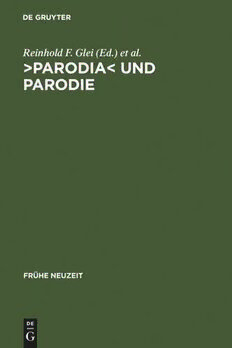
>Parodia Aspekte intertextuellen Schreibens in der lateinischen Literatur der Frühen Neuzeit 'Parodia' and Parody. Aspects of intertextual writing in the Latin literature of the early modern age Edited by: Reinhold F. Glei and Robert Seidel Volume 120 in PDF
372 Pages·2006·22.365 MB·German
Most books are stored in the elastic cloud where traffic is expensive. For this reason, we have a limit on daily download.
Preview >Parodia Aspekte intertextuellen Schreibens in der lateinischen Literatur der Frühen Neuzeit 'Parodia' and Parody. Aspects of intertextual writing in the Latin literature of the early modern age Edited by: Reinhold F. Glei and Robert Seidel Volume 120 in
Description:
Literary scholars have long been aware of the phenomenon of intertextuality in the early modern age and hence in neo-Latin literature. Yet so far there have been very few historical or systematic studies engaging with specific adaptation procedures operating between individual texts or classes of text. This volume presents an initial sequence of case studies on the use of intertextual writing strategies such as parody, contrafactum, or cento in the Latin literature of Europe from the 15th to the 17th century. They are based on new research approaches centering around text typology and the history of literary functions.
See more
The list of books you might like
Most books are stored in the elastic cloud where traffic is expensive. For this reason, we have a limit on daily download.
